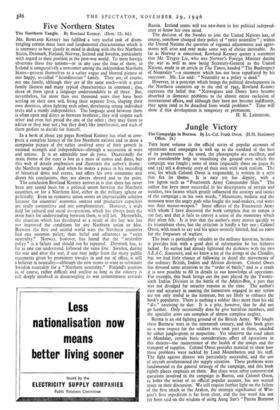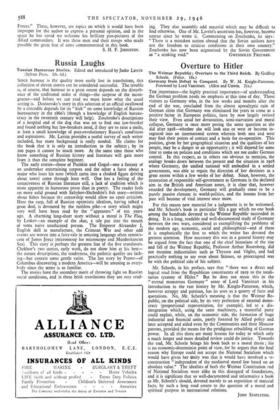Jungle Victory
THIS latest volume in the official series of popular accounts of operations and campaigns is well up to the standard of the best of its predecessors. As usual, the photographs are excellent, and give considerable help in visualising the ground over which the campaign was fought ; some of them (especially those on pages 85 and 131) tell a dramatic story of their own with stark realism. The text, for which Colonel Owen is responsible, is written in a style that fits its theme. It is racy yet has dignity, with a few lapses such as " Fourteenth Army Commander Slim." The author has been most successful in his descriptions of terrain and weather, two factors which greatly influenced the strategy and tactics of the campaign ; in his own words, "Mountains, malaria and the monsoon were the angry gods who fought the road-makers, and water was their master-weapon." Some officers of the Fourteenth Army with whom I have discussed the book complain that its tempo is too fast, and that it fails to convey a sense of the monotony which they often felt. It is true that the author's story moves quickly to its triumphant close, but the criticism is hardly a fair one ; Colonel Owen, with much to say and his space severely limited, had no room for the longueurs of warfare.
The book is particularly valuable to the military historian, because it provides him with a good deal of information he has hitherto lacked. Its author had already lightened the darkness with his two S.E.A.C. Souvenirs, and we knew a lot of the doings of the Chindits, but we had little chance of following in detail the movements of the ordinary British, Indian and African divisions. Colonel Owen has devoted some attention to the "order of battle," and as a result it is now possible to fill in details in our knowledge of operations. For example, this book brings out the part played by the Twenty- sixth Indian Division in the battle of the Admin-Box, a part that was not divulged for security reasons, at the time. The author's care and accuracy in naming the formations engaged in any action are not only useful to the historian, but are likely to enhance the book's popularity. There is nothing a soldier likes more than his old " div." receiving its due. It is a pity, however, that he did not go further. Only occasionally does he give battalion numbers, and the specialist arms can complain of almost complete neglect.
Burma is an old fighting ground of the British Army. We fought three Burmese wars in the nineteenth century, and this book gives us a new respect for the soldiers who took part in them, unaided by either jungle-green or mepacrine. Yet whatever the road taken to Mandalay, certain basic considerations affect all operations in this theatre—the maintenance of the health of the troops and the transport of supplies. Colonel Owen provides material to show how these problems were tackled by Lord Mountbatten and his staff. The fight against disease was particularly successful, and the use of aircraft revolutionised the supply situation. These problems were fundamental to the general strategy of the campaign, and this book rightly places emphasis on them. But there were other controversial questions involved in the campaign in Burma, and Colonel Owen, as befits the writer of an official popular account, has not wasted space on their discussion. We still require further light on the failure of the first attack in the Arakan, the strategic significance of Win- gate's first expedition is far from clear, and the last word has not yet been said on the wisdom of using Aung San's " Patriot Burmese,
Forces." These, however, are topics on which it would have been improper for the author to express a personal opinion, and in the space he has saved we welcome his brilliant pen-pictures of the Allied commanders. It was these men and their troops who made possible the great feat of arms commemorated in this book.
S. H. F. JOHNSTON.



































 Previous page
Previous page